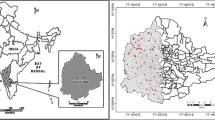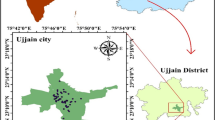Abstract
Monitoring and forecasting of chemical and physicochemical parameters of groundwater is an important factor in quality control and water management. In order to optimize these processes, the initial purpose of this paper was to identify sources of pollution and predict spatial changes in groundwater quality. Patterns of spatial changes in groundwater quality in the Danube river basin (Serbia) have been identified using multivariate statistical techniques. The results of the applied cluster analysis are the indicators of the existance of two spatial clusters. The principal component/factor analysis (PCA/FA) has shown that beside natural, anthropogenic factor has an influence in spatial grouping. Discriminant analysis (DA) was applied in order to identify discriminant groundwater quality parameters. DA reduced the number of data by extracting two parameters (iron and arsenic). The spatial distribution of identified dominant factors and discriminant parameters were graphically represented using GIS. Finally, the artificial neural network technique was used to test the ability to predict spatial changes in the values of discriminant parameters, and the reliability of this technique to predict the spatial variations of the two extracted variables has been proven.








Similar content being viewed by others
References
Ani, E. C., Hutchins, M., Kraslawski, A., & Agachi, P. S. (2011). Mathematical model to identify nitrogen variability in large rivers. River Research and Applications, 27, 1216–1236. https://doi.org/10.1002/rra.1418.
Arslan, O. (2013). Spatially weighted principal component analysis (PCA) method for water quality analysis. Water Resources, 40(3), 315–324. https://doi.org/10.1134/S0097807813030111.
Chen, W. B., & Liu, W. C. (2014). Artificial neural network modeling of dissolved oxygen in reservoir. Environmental Monitoring and Assessment, 186(2), 1203–1217. https://doi.org/10.1007/s10661-013-3450-6.
Dević, G., Djordjević, D., & Sakan, S. (2014). Natural and anthropogenic factors affecting the groundwater quality in Serbia. Science of The Total Environment, 468-469, 933–942. https://doi.org/10.1016/j.scitotenv.2013.09.011.
Fadiran, A. O., Dlamini, S. C., & Mavuso, A. (2008). A comparative study of the phosphate levels in some surface and groundwater bodies of Swaziland. Bulletin of Chemical Society of Ethiopia, 22(2), 197–206. https://doi.org/10.4314/bcse.v22i2.61286.
Fan, L. O., Wu, Z. C., Zhang, Q. Y., Liu, Q., & Yu, B. (2013). Multivariate statistical methods for recognition of water quality feature in Meiliang Bay of Taihu Lake. Journal of Zhejiang University (Science Edition), 40(3), 308–315.
Gulgundi, M. S., & Shetty, A. (2018). Groundwater quality assessment of urban Bengaluru using multivariate statistical techniques. Applied Water Science, 8(43), 1–15. https://doi.org/10.1007/s13201-018-0684-z.
Helena, B., Pardo, R., Vega, M., Barrado, E., Fernandez, J. M., & Fernandez, L. (2000). Temporal evolution of groundwater composition in an alluvial aquifer (Pisuerga River, Spain) by principal component analysis. Water Research, 34, 807–816. https://doi.org/10.1016/S0043-1354(99)00225-0.
Janardhana Raju, N. (2006). Iron contamination in groundwater: A case from Tirumala-Tirupati environs, India. The Researcher, 1(1), 32–35.
Kim, J. O., & Mueller, C. W. (1987). Introduction to factor analysis: what it is and how to do it. In Sage University Paper Series on Quantitative Applications in the Social Sciences. Newbury Park: Sage.
Krishna, A. K., Mohan, K. R., & Dasaram, B. (2019). Assessment of groundwater quality, toxicity and health risk in an industrial area using multivariate statistical methods. Environmental Systems Research, 8(26), 1–17. https://doi.org/10.1186/s40068-019-0154-0.
Liu, C. W., Lin, K. H., & Kuo, Y. M. (2003). Application of factor analysis in the assessment of groundwater quality in a blackfoot disease area in Taiwan. Science of The Total Environment, 313(1-3), 77–89. https://doi.org/10.1016/s0048-9697(02)00683-6.
Maier, H. R., & Dandy, G. C. (2000). Neural networks for the prediction and forecasting of water resources variables: a review of modeling issues and applications. Environmental Modeling and Software, 15, 101–124. https://doi.org/10.1016/S1364-8152(99)00007-9.
Majkić-Dursun, B., Oros, I., Oparušić, I., & Petković, A. (2019). Assessing Groundwater Quality for Multiuse and Geochemical Evolution in the South Banat Area of Serbia, Pannonian Basin. Polish Journal of Environmental Studies, 28(5), 3269–3278. https://doi.org/10.15244/pjoes/94046.
Milanović, A., Kovačević-Majkić, J., & Milivojević, M. (2010). Water quality analysis of Danube river in Serbia: Pollution and protection problems. Glasnik srpskog geografskog društva, 90, 47–68 (in Serbian).
Mrazovac, S., Vojinović-Miloradov, M., Matić, I., & Marić, N. (2013). Multivariate statistical analyzing of chemical parameters of groundwater in Vojvodina. Geochemistry, 73(2), 217–225. https://doi.org/10.1016/j.chemer.2012.11.002.
Mustapha, A., & Aris, A. Z. (2012). Multivariate statistical analysis and environmental modeling of heavy metals pollution by industries. Polish Journal of Environmental Studies, 21, 1359–1367.
Naoum, S., & Tsanis, I. K. (2004). Ranking of spatial interpolation techniques using a GIS-based DSS. Global Nest: International Journal, 6(1), 1–20.
Nienie, A. B., Sivalingam, P., Laffite, A., Ngelinkoto, P., Otamonga, J. P., Matand, A., Mulaji, C. K., Mubedi, J. I., Mpiana, P. T., & Pote, J. (2017). Seasonal variability of water quality by physicochemical indexes and traceable metals in suburban area in Kikwit, Democratic Republic of the Congo. International Soil and Water Conservation Research, 5, 158–165. https://doi.org/10.1016/j.iswcr.2017.04.004.
Norman, J., Sparrenbom, C. J., Berg, M., Duc Nhan, D., Jacks, G., Harms-Ringdahl, P., Quy Nhan, P., & Rosqvist, H. (2015). Tracing sources of ammonium in reducing groundwater in a well field in Hanoi (Vietnam) by means of stable nitrogen isotope (δ15N) values. Applied Geochemistry, 61, 248–258. https://doi.org/10.1016/j.apgeochem.2015.06.009.
Orzepowski, W., & Pulikowski, K. (2008). Magnesium, calcium, potassium and sodium content in groundwater and surface water in arable lands in the commune (GMINA) of Katy Wroclawskie. Journal of Elementology, 13(4), 605–614.
Panno, S., Hackley, K.C., Hwang, H.H., Greenberg, S., Krapac, I.G., Landsberger, S., O’Kelly, D.J. (2002). Source Identification of Sodium and Chloride Contamination in Natural Waters: Preliminary Results. Proceedings, 12th Annual Illinois Groundwater Consortium Symposium, Makanda, IL.
RaheliNamin, B., & Mohseni, B. (2018). Integrated Artificial Neural Network Modeling and GIS for Identification of Important Factor on Groundwater Hydrochemistry (Fe-, Ca2+ and PO4-3). Archives of Hygiene Sciences, 7(2), 126–133.
Ravikumar, P., & Somashekar, R. K. (2012). Assessment and modeling of groundwater quality data and evaluation of their corrosiveness and scaling potential using environmetric methods in Bangalore south taluk. Karnataka state India. Water Resources, 39(4), 446–473. https://doi.org/10.1134/S0097807812040112.
Sayyed Juned, A., & Bhosle Arjun, B. (2011). Analysis of Chloride, Sodium and Potassium in Groundwater Samples of Nanded City in Mahabharata, India. European Journal of Experimental Biology, 1(1), 74–82.
Shankar, S., Shanker, U., & Shikha. (2014). Arsenic Contamination of Groundwater: A Review of Source, Prevalence, Health Risks, and Strategies for Mitigation. The Scientific World Journal, 2014, 1–18. https://doi.org/10.1155/2014/304524.
Simeonov, V., Sarbu, C., Massart, D. L., & Tsakovski, S. (2001). Danube river water data modeling by multivariate data analysis. Mikrochimica Acta, 137(3-4), 243–248. https://doi.org/10.1007/s006040170017.
Simeonov, V., Stratis, J. A., Samara, C., Zachariadis, G., Voutsa, D., Anthemidis, A., Sofoniou, M., & Kouimtzis, T. (2003). Assessment of the surface water quality in Northern Greece. Water Research, 37, 4119–4124. https://doi.org/10.1016/S0043-1354(03)00398-1.
Singh, P. K., Malik, A., & Sinnha, S. (2005). Water quality assessment and apportionment of pollution sources of Gomti river (India) using multivariate statistical techniques – a case study. Analytica Chimica Acta, 538(1-2), 355–374. https://doi.org/10.1016/j.aca.2005.02.006.
Stojković, J., Papić, P., Ćuk, M., & Todorović, M. (2013). Application of factor analysis in identification of dominant hydrogeochemical processes of some nitrogenous groundwater of Serbia. Geološki anali Balkanskog poluostrva, 74, 57–62. https://doi.org/10.2298/GABP1374057S.
Thair, S. K., Abdul Hameed, M. J., & Ayad, S. M. (2014). Prediction of water quality of Euphrates river by using artificial neural network model (spatial and temporal study). International Research Journal of Natural Sciences, 2(3), 25–38.
Usman, N. U., Toriman, M. E., Juahir, H., Abdullahi, M. G., Rabiu, A. A., & Isiyaka, H. (2014). Assessment of Groundwater Quality Using Multivariate Statistical Techniques in Terengganu. Science and Technology, 4(3), 42–49. https://doi.org/10.5923/j.scit.20140403.02.
Vasić, L., Živojinović, D., & Rajković-Ognjanović, V. (2020). Hydrochemical changes and groundwater grouping data by multivariate statistical methods within one karst system: recharge-discharge zone (Eastern Serbia case study). Carbonates Evaporites, 35(15). https://doi.org/10.1007/s13146-019-00548-6.
Vastag, G., Apostolov, S., Perišić-Janjić, N., & Matijević, B. (2013). Multivariate analysis of chromatographic retention data and lipophilicity of phenyl acetamide derivates. Analytica Chimica Acta, 767(1), 44–49. https://doi.org/10.1016/j.aca.2013.01.002.
Vega, M., Pardo, R., Barrado, E., & Deban, L. (1998). Assessment of seasonal and polluting effects on the quality of river water by exploratory data analysis. Water Research, 32, 3581–3592. https://doi.org/10.1016/S0043-1354(98)00138-9.
Voza, D., & Vuković, M. (2018). The assessment and prediction of temporal variations in surface water quality – a case study. Environmental Monitoring and Assessment, 190(434), 1–16. https://doi.org/10.1007/s10661-018-6814-0.
Voza, D., Vuković, M., Takić, L., Nikolić, Đ., & Mladenović-Ranisavljević, I. (2015). Application of multivariate statistical techniques in the water quality assessment of Danube river, Serbia. Archives of Environmental Protection, 41(4), 96–103. https://doi.org/10.1515/aep-2015-0044.
Wen, X., Fang, J., Diao, M., & Zhang, C. (2013). Artificial neural network modeling of dissolved oxygen in the Heihe River, Northwestern China. Environmental Monitoring and Assessment, 185, 4361–4371. https://doi.org/10.1007/s10661-012-2874-8.
Acknowledgements
The work was financially supported by the Ministry of Education, Science and Technological Development of the Republic of Serbia (Grant No, 451-03-68/2010-14/200026). The authors would also like to thank the Faculty of Information Technology and Engineering, University UNION-Nikola Tesla, Belgrade, for their support and cooperation.
Author information
Authors and Affiliations
Corresponding author
Additional information
Publisher’s Note
Springer Nature remains neutral with regard to jurisdictional claims in published maps and institutional affiliations.
Highlights
• Cluster analysis grouped measuring locations in two clusters (cluster 1 included 16 measuring spots and cluster 2 seven measuring spots).
• Application of multivariate statistical techniques in order to identify dominant factors and discriminant parameters.
• PCA/FA for identified seven dominant factors for cluster 1 and five for cluster 2.
• Application of discriminant analysis identified two discriminant parameters.
• GIS interpolation technique—IDW enabled creating spatial distribution maps for dominant factors (for both clusters) and discriminant parameters.
• Application of artificial neural networks (ANNs) enabled predicting spatial varifactors.
Rights and permissions
About this article
Cite this article
Ilić, I., Puharić, M. & Ilić, D. Groundwater Quality Assessment and Prediction of Spatial Variations in the Area of the Danube River Basin (Serbia). Water Air Soil Pollut 232, 117 (2021). https://doi.org/10.1007/s11270-021-05069-4
Received:
Accepted:
Published:
DOI: https://doi.org/10.1007/s11270-021-05069-4




